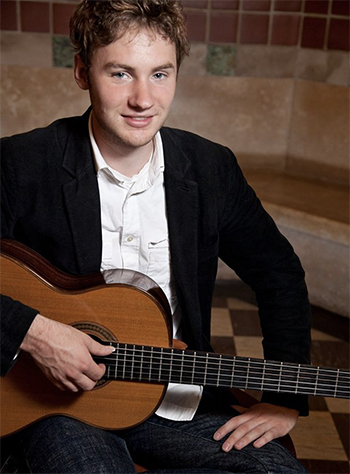by Mike Telin

On Saturday, September 15 at 7:30 pm in the Maltz Performing Arts Center, Aron and Collins will be joined by fellow guitarist Colin Davin during the Cleveland Classical Guitar Society’s annual Showcase Concert. The program will include Mauro Giuliani’s Rossiniana No. 1 along with selections from Aron’s Menagerie, Sixteen Concert Studies for Guitar (2018) and the premiere of Collins’ Impressions for Viola and Guitar. The free event is part of the inaugural Silver Hall Concert Series.
Aron, who has been teaching at the Oberlin Conservatory since 1992 (he also taught at the University of Akron for thirty-four years), has often felt “boxed in” by the limited number of concert studies available to him as a teacher. “Then it finally hit me — I should just write my own,” he said during a telephone conversation.
“Writing a study is an interesting puzzle to try to solve. You clearly have a pedagogical point to make, but in order to write a piece that anyone will want to play and listen to, you also have to make it musically interesting.”
Aron said there were a number of specific technical problems he wanted to address. He will present five of his problem-solving etudes on Saturday, beginning with “The Magpie.” That study covers cross-string trills, which “create the sound of a trill between two different strings,” Aron said. “They sound a little bit more like a piano or a harpsichord trill where you get a refined articulation. But in order to go fast enough so it sounds like a trill, it involves a complicated fingering and it takes a bit of work to sort it out.”
For “The Coyote,” Aron took on the intellectual challenge of writing imitative counterpoint. “Counterpoint is one of the most difficult things we do on the guitar. Imitative counterpoint is nice because whatever you hear in one voice is immediately heard again in a different voice.”
“The Albatross” focuses on the uses of tremolo, a technique that everybody knows the sound of when they hear it, Aron said. “It’s used in some of the most famous pieces for the guitar — playing fast, repeated notes very evenly to sustain the sound. But we do it with three-finger sequences so it takes some practice.”

Why did the guitarist choose to name each study after an animal? “The simple answer is that I wanted to give them more colorful names than Etudes One, Two, Three. There are also relationships between the animals and the music which are sometimes obvious and other times a little more obscure.”
Jeremy Collins said that his composition grew out of the opportunity for him to perform with his brother, Cleveland Orchestra principal viola Wesley Collins. “Wes and I have wanted to play together for a couple of years,” the guitarist said during a separate interview. “So when Erik Mann from the Guitar Society asked if we were interested in playing on this concert, we said, sure.”
He also said the project soon became a case of necessity being the mother of invention. “We looked around for music we could play, and as I searched I found a few things for viola and guitar. But the repertoire wasn’t very expansive so we decided to write our own piece.”
Collins and his brother grew up loving the music of Debussy and Ravel, which influenced the style of Impressions. “There’s a little bit of Prokofiev and a little quote from one of the Borodin string quartets, but it’s very much an impressionist piece — a lot of chords and flowing arpeggios. And I tune the guitar to a dominant 9th chord, which helps the instrument sound more impressionistic.”

The project has also been an opportunity for Collins to return to his creative roots. “Composing was something I did all through college, so this was a good wake-up call for me to do it more. It is rewarding.”
Jeremy Collins began his musical studies playing violin and piano. “My parents were my teachers — my dad played in the Cincinnati Symphony so music was very important to them,” he said. “But it didn’t go well, I didn’t enjoy it. My dad finally realized that I wanted to play the guitar and when he bought me one, it was the first time I really appreciated music.”
The Collins brothers both studied at the Cleveland Institute of Music. “We shared an apartment along with our younger brother Zach, so for a period of two to three years we all lived together.” Zachary Collins is a now a violist in the Indianapolis Symphony. “Wes and I are really excited about this concert. We’ve played some wedding gigs but this is our first real performance together.”
Published on ClevelandClassical.com September 11, 2018.
Click here for a printable copy of this article



